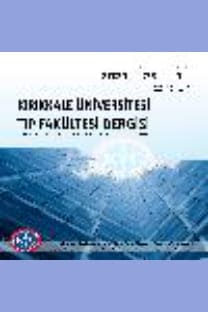Rotator Cuff Patolojilerinin Değerlendirilmesinde Ultrasonografi ve Manyetik Rezonans Görüntülemenin Karşılaştırılması
Rotator manşet, omuz, ultrasonografi, yırtık
COMPARISON OF ULTRASONOGRAPHY AND MAGNETIC RESONANCE IMAGING IN EVALUATING ROTATOR CUFF PATHOLOGIES
tor cuff, shoulder, ultrasonography, tear,
___
- 1. Naqvi GA, Jadaan M, Harrington P. Accuracy of ultrasonography and magnetic resonance imaging for detection of full thickness rotator cuff tears. Int J Shoulder Surg. 2009;3:94-7.
- 2. Mitchell C, Adebajo A, Hay E, Carr A. Shoulder pain: diagnosis and management in primary care. BMJ. 2005;331:1124-8.
- 3. Milosavljevic J, Elvin A, Rahme H. Ultrasonography of the rotator cuff: a comparison with arthroscopy in one hundred and ninety consecutive cases. Acta Radiol. 2005;46:858-65.
- 4. Moosmayer S, Smith HJ, Tariq R, Larmo A. Prevelance and characteristics of asymptomatic tears of the rotator cuff: an ultrasonographic and clinical study. J Bone Joint Surg Br. 2009;91:196-200.
- 5. Seibold CJ, Mallisee TA, Erickson SJ, Boynton MD, Raasch WG, Timins ME. Rotator cuff: evaluation with US and MR imaging. Radiographics. 1999;19:685-705.
- 6. Oh CH, Schweitzer ME, Spettell CM. Internal derangements of the shoulder: decision tree and cost-effectiveness analysis of conventional arthrography, conventional MRI, and MR arthrography. Skeletal Radiol. 1999;28:670-8.
- 7. Şahan MH. Rotator Cuff Patolojilerinin Değerlendirilmesinde Ultrasonografi ve Manyetik Rezonans Görüntülemenin Karşılaştırılması. Sağlık bakanlığı Okmeydanı Eğitim ve Araştırma Hastanesi Radyoloji kliniği. Uzmanlık Tezi. İstanbul: 2006.
- 8. Seeger LL, Gold RH, Bassett LW, Ellman H. Shoulder impingement syndrome: MR findings in 53 shoulders. AJR Am J Roentgenol. 1988;150:343-7.
- 9. Rutten MJ, Maresch BJ, Jager GJ, Blickman JG, Van Holsbeeck MT. Ultrasound of the rotator cuff with MRI and anatomic correlation. Eur J Radiol. 2007;62:427-36.
- 10. Brandt TD, Cardone BW, Grant TH, Post M, Weiss CA. Rotator cuff sonography: a reassessment. Radiology. 1989;173:323-7.
- 11. Hinsley H, Nicholls A, Daines M, Wallace G, Arden N, Carr A. Classification of rotator cuff tendinopathy using high definition ultrasound. Muscles Ligaments Tendons J. 2014;4(3):391-7.
- 12. Edward IB, Peter HA, Carol BB, Philip WR. Ultrasound; a practical approach to clinical problems. 2th ed. New York. Thieme Medical Publishers. 2008: 486.
- 13. Weinreb JH, Sheth C, Apostolakos J, et al. Tendon structure, disease, and imaging. Muscles Ligaments Tendons J. 2014;4(1):66-73.
- 14. Kang CH, Kim SS, Kim JH, et al. Supraspinatus tendon tears: comparison of 3D US and MR arthrography with surgical correlation. Skeletal Radiol. 2009;38(11):1063-9.
- 15. Neer CS. II. Anterior acromioplasty for chronic impingement syndrome of shoulder. J. Bone Joint Surg. 1972;54:41-50.
- 16. Farley TE, Neumann CH, Steinbach LS, Jahnke AJ, Petersen SS. Full thickness tears of the rotator cuff of shoulder diagnosis with MR imaging. AJR. 1992;158:347-51.
- 17. Westhoff B, Wild A, Werner A, Schneider T, Kahl V, Krauspe R. The value of ultrasound after shoulder arthroplasty. Skeletal Radiol. 2002;31:695-701.
- 18. Al-Shawi A, Badge R, Bunker T. The detection of full thickness tears using ultrasound. J Bone Joint Surg Br. 2008;90:889-92.
- 19. Kaneko K, DeMouy EH, Brunet ME. MR Evaluation of rotator cuff impingment: correlation with confirmed full-thickness rotator cuff tears. Journal of Computer Assisted Tomography. 1994;18:225-8.
- 20. Hsu HC, Luo ZP, Stone JJ, Huang TH, An KN. Correlation between rotator cuff tear and glenohumeral degeneration. Acta Orthop Scand. 2000;74:89-94.
- 21. Esenyel CZ, Demirhan M, Duygulu F. Arthroscopic evaluation of the mobility of the meso-acromion. Acta Orthop Traumatol Turc. 2005;39:391-5.
- 22. Hirano M, Ide J, Takagi K. Acromial shapes and extension of rotator cuff tears: magnetic resonance imaging evaluation. J Shoulder Elbow Surg. 2002;11:576-8.
- 23. Vlychou M, Dailiana Z, Fotiadou A, Papanagiotou M, Fezoulidis IV, Malizos K. Symptomatic partial rotator cuff tears: Diagnostic performance of ultrasound and magnetic resonance imaging with surgical correlation. Acta Radiol. 2009;50(1):101-5.
- 24. Chang CY, Wang SF, Chiou HJ, Ma HL, Sun YC, Wu HD. Comparison of shoulder ultrasound and MR imaging in diagnosing full-thickness rotator cuff tears. Clin Imaging. 2002;26(1):50-4.
- ISSN: 2148-9645
- Yayın Aralığı: Yılda 3 Sayı
- Başlangıç: 1999
- Yayıncı: KIRIKKALE ÜNİVERSİTESİ KÜTÜPHANE VE DOKÜMANTASYON BAŞKANLIĞI
ERKEK HASTALARIN PROSTAT KANSERİ TARAMALARI HAKKINDA BİLGİ DÜZEYLERİ
ÖZLEM CEYHAN, Songül GÖRİŞ, ABDULLAH DEMİRTAŞ, ZÜLEYHA KILIÇ
YÜKSEK VOLTAJ ELEKTRİK ÇARPMASINDA AMANTADİN TEDAVİSİ
GÜLÇİN AYDIN, IŞIN GENÇAY, SELİM ÇOLAK
Akut Skrotal Ağrıda Difüzyon Ağırlıklı Manyetik Rezonans Görüntülemenin Rolü
MEHMET BEYAZAL, Hasan Rıza AYDIN, Maksude Esra KADIOĞLU, FATMA BEYAZAL ÇELİKER, Mehmet Fatih İNECİKLİ, Tuğba ELDEŞ, HÜSEYİN EREN
Cama Yumruk Atan Hastaların Demografik, Anatomik ve Klinik Özellikleri
DUYGU GÖLLER BULUT, Gözde ÖZCAN, Fatma AVCI
NADİR GÖRÜLEN SKROTAL LEZYON: SKROTAL HEMANJİOM OLGU SUNUMU
Mustafa Koray KIRDAĞ, Fatih BAL, DEVRİM TUĞLU
SAKRUM’UN MULTİDEDEKTÖR BİLGİSAYARLI TOMOGRAFİ YÖNTEMİ İLE MORFOMETRİK ANALİZİ
Musa ACAR, Şenay Burçin ALKAN, Mehmet Sedat DURMAZ, Erdi SEÇKİN, Kübra ÖZTEMEL, Zeynep SEZGİN, Aleyna AKBABA
İKİ OLGU İLE HEREDİTER ANJİYOÖDEMLİ HASTALARA PREOPERATİF YAKLAŞIMIN GÖZDEN GEÇİRİLMESİ
HÜLYA NAZİK, PERİHAN ÖZTÜRK, MEHMET KAMİL MÜLAYİM, İnci DALYAN
